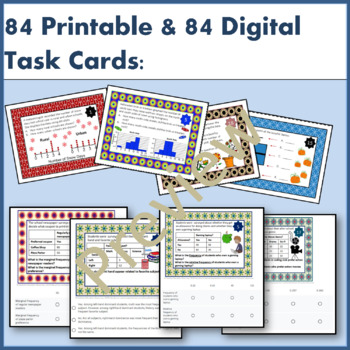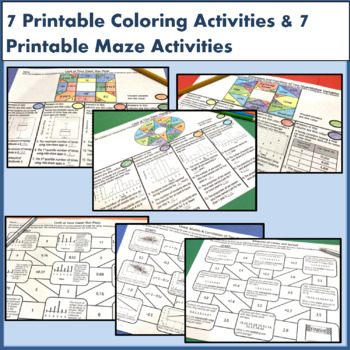Bundle: Algebra I Statistics Activities (Common Core Aligned)
- Zip
- Google Apps™

Products in this Bundle (28)
showing 1-5 of 28 products
Also included in
- This MEGA bundle includes 10 Common Core Aligned lessons, 4 statistics vocabulary lists (1 master list for the whole unit, and 3 smaller unit “sub lists”), 1 mid-unit integrated mini-review and worksheet (as homework or a quiz!), and 1 exam with answer key, and over 20 printable and digital statistiPrice $65.99Original Price $102.35Save $36.36
Description
This BIG bundle includes multiple printable and digital statistics activities aligned with Common Core standards typically covered in Algebra 1. Students practice solving problems on measurement, count, quantitative, and categorical data in these activities. Students use both computation and contextual interpretation to solve problems. Problems range from introductory to challenging to support differentiation and scaffolding.
These activities are great for subs, independent work, early finishers, exam review, and extra practice.
Answer keys included!
Bundle Bonuses:
We’re offering the bundle at a discount of over 30% off of the a la carte price.
This Algebra I Statistics Activities Bundle materials cover the following topics:
Dot plots, histograms, median and interquartile range, mean and standard deviation, comparing different datasets, shapes of distributions; outliers, two-way frequency tables of categorical variables, relative frequency, conditional relative frequency, scatterplots, functional relationships between two quantitative variables (linear, quadratic, exponential), correlation coefficient, interpretation of linear models, residuals
Common Core Standards:
HSS.ID.A.1: Represent data with plots on the real number line (dot plots, histograms, box plots).
HSS.ID.A.2: use statistics appropriate to the shape of the data distribution to compare center. (median, mean) and spread (interquartile range, standard deviation) of two or more different datasets.
HSS.ID.A.3: Interpret differences in shape, center, and spread in the context of the data sets, accounting for possible effects of extreme data points (outliers).
HSS.ID.B.5: Summarize, represent, and interpret data on two categorical variables in two-way frequency tables; interpret frequencies; and recognize possible associations and trends in the data.
HSS.ID.B.6: Represent two quantitative variables on a scatterplot and describe how the variables are related.
HSS.ID.B.6.A: Fit a function to the data; use functions fitted to data to solve problems in the context of data. Use given functions or choose a function suggested by the context. Emphasize linear, quadratic, and exponential models.
HSS.ID.B.6.C: Fit a linear function for a scatterplot that suggests a linear association.
HSS.ID.C.7: Interpret the slope (rate of change) and intercept (constant term) of a linear model in the context of data.
HSS.ID.C.8: Compute (using technology) and interpret the correlation coefficient of a linear fit.
HSS.ID.C.9: Distinguish between correlation and causation.
About this product:
Each activity is available in separate *.PDF or *.ZIP files.
This purchase is to be used by one teacher only for classroom use. These materials may not be shared without purchasing the appropriate number of licenses. With the exception of remote learning, these materials may not be uploaded to the internet in any form (classroom websites, personal websites, or network drives, etc.).
Prefer to purchase activities a la carte? Each resource can be found here:
Look at your Data! Task Cards (Common Core Aligned)
Task Cards for Center, Spread, Shapes of Distributions, & Outliers (Common Core)
Task Cards: Categorical Data and Two-Way Tables (Common Core Aligned)
Task Cards: Scatter Plots, Linear Models, Functions, Correlation (Common Core)
Distance Learning: Look at your Data! Digital Task Cards for Dot Plots, Histograms, Boxplots (Common Core Aligned)
Distance Learning: Digital Task Cards | Center, Spread, Shapes, Outliers (Common Core)
Distance Learning: Digital Task Cards for Categorical Data and Two-Way Tables (Common Core)
Distance Learning: Digital Task Cards for Scatterplots, Models, Correlation (Common Core)
Look at Your Data!: Dot Plot Coloring Activity (Common Core Aligned)
Look at Your Data!: Histograms Coloring Activity (Common Core Aligned)
Look at Your Data!: Box Plots Coloring Activity (Common Core Aligned)
Categorical Data and Two-Way Tables Coloring Activity (Common Core)
Measures of Center and Spread Coloring Activity (Common Core)
Scatterplots and Functions of Quantitative Data Coloring Activity (Common Core)
Linear Models, Residuals, and Correlation Quantitative Data Coloring Activity
Look at Your Data!: Dot Plot Maze Activity (Common Core)
Look at Your Data!: Histogram Maze Activity (Common Core)
Look at Your Data!: Box Plot Maze Activity (Common Core)
Two-Way Tables of Categorical Data Maze Activity (Common Core Aligned)
Measures of Center and Spread Maze Activity (Common Core)
Scatterplots and Functions of Quantitative Data Maze Activity (Common Core)
Linear Models & Correlation of Quantitative Data Maze Activity (Common Core)
Distance Learning: Digital Scatterplot, Linear Model, Correlation Activity
Distance Learning: Investigate COVID-19 using Statistics with Real-World Data Distance Learning: Investigate a COVID-19 Correlate using Linear Models with Real-World Data
Distance Learning: Careers in Statistics Project
Distance Learning: FREE Stat Libs Interactive Statistics Vocabulary Activity
Statistics: Plots, Shapes of Distributions, Choosing Mean or Median
Additional Tips:
Follow Statistics Education Resources on Pinterest!
Want to earn TeachersPayTeachers credit for discounts on future purchases?
1) Login and visit your ‘My Purchases’ page
2) Click the ‘Provide Feedback’ button.
3) Leave a rating and quick comment.
4) Your feedback will help in creating future products for the teaching community.
Want to be first to learn more about Statistics Education Resources products?
1) Look for the green star near the top of the page by the store name, Statistics Education Resources.
2) Click it to be first to know about my new products, freebies, and discounts!
© Statistics Education Resources, 2019-2022
Disclaimer:
The National Governors Association Center for Best Practices and Council of Chief State School Officers are the sole owners and developers of the Common Core State Standards. © Copyright 2010. National Governors Association Center for Best Practices and Council of Chief State School Officers. All rights reserved.
This product is the work of Statistics Education Resources. Claims of alignment with the Common Core State Standards are the personal opinion of Statistics Education Resources and do not necessarily reflect the official views of the National Governors Association Center for Best Practices and Council of Chief State School Officers. No association with or endorsement by the National Governors Association Center for Best Practices and Council of Chief State School Officers is intended or implied.






